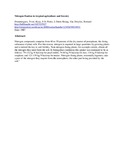| dc.description.abstract | Nitrogen compounds comprise from 40 to 50 percent of the dry matter of protoplasm, the living substance of plant cells. For this reason, nitrogen is required in large quantities by growing plants and is indeed the key to soil fertility. Non-nitrogen-fixing plants, for example cereals, obtain all the nitrogen they need from the soil. In Senegalese conditions this uptake was estimated to be as follows: 79-132 kg N ha/crop for pearl millet; 74-84 kg N ha/crop for rice; 134 kg N hdcrop for sorghum; and 121-139 kg N ha/crop for maize. Nitrogen-fixing plants, essentially legumes, take a part of the nitrogen they require from the atmosphere, the other part being provided by the soil." | en |

